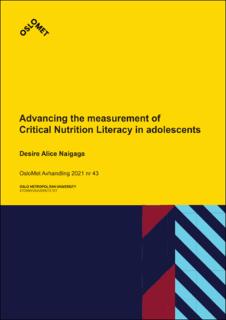| dc.contributor.advisor | Guttersrud, Øystein | |
| dc.contributor.author | Naigaga, Desire Alice | |
| dc.date.accessioned | 2022-01-12T16:21:26Z | |
| dc.date.available | 2022-01-12T16:21:26Z | |
| dc.date.issued | 2022 | |
| dc.identifier.isbn | 978-82-8364-347-3 | |
| dc.identifier.isbn | 978-82-8364-361-9 | |
| dc.identifier.issn | 2535-5414 | |
| dc.identifier.uri | https://hdl.handle.net/11250/2837170 | |
| dc.description.abstract | Aim: To evaluate the psychometric properties of scales measuring adolescents’ proficiency to critically appraise nutrition information, their engagement in dietary behaviour and self-efficacy in the science topic ‘Body and Health’, and test a theoretical model linking these latent traits. Methods: A sample of 1622 tenth graders at 58 randomly sampled schools in Norway voluntary responded to a questionnaire containing the three scales. The scale measuring adolescents’ proficiency to critically appraise nutrition information was validated by applying the partial credit parameterization of the polytomous unidimensional Rasch model. The scale measuring self-efficacy in the science topic ‘Body and Health’ was validated by using the partial credit parameterization of the polytomous unidimensional Rasch model and confirmatory factor analysis. The theoretical model linking the latent traits was tested by using structural equation modelling. Structural equation modelling was preferred to regression models as this method properly handles latent traits measured with standard errors. The data was tested up against the appropriate Rasch model by using the statistical software package RUMM2030. The confirmatory factor model and the “structural equation modelling” model were estimated by using the statistical software package Lisrel 9. Owing to data at the ordinal measurement level, “diagonally weighted least square” estimation was applied. “Goodness of fit” indexes were also estimated by using robust maximum likelihood estimation, as published target values typically rely on this type of estimation. Main results: The data collected sufficiently fit the polytomous unidimensional Rasch model. Confirmatory factor analysis displayed strong standardized factor loadings, which strengthened the idea of one underlying latent factor (unidimensional scale). The scales were slightly less than optimally targeted for the sample, as the distribution of person location estimates were somewhat shifted toward higher values than the distribution of item threshold locations. Overall, the scales were reliable and able to separate between students with different standing on the latent trait. The theoretical model was empirically strengthened, which means that the model implied variance-covariance matrix fairly well reproduced the observed variance-covariance matrix. Conclusions: Valid and reliable scales for measuring adolescents’ critical nutrition literacy were established, and self-efficacy in the health-related science topic explained variation in students’ critical nutrition literacy. Hence, there is a relation between adolescents’ self-perceived nutrition literacy and self-perceived health-related scientific literacy. | en_US |
| dc.description.abstract | Hensikt: Å evaluere de psykometriske egenskapene til måleskalaer som måler ungdoms evne til å kritisk vurdere ernæringsinformasjon (CNL-E), deres engasjement i kostholdsendrende atferd (CNLEng) og mestringsforventning i kjerneelementet «Kropp og helse», samt å teste en modell som beskriver sammenhenger mellom disse latente trekkene. Metoder: Måleskalaene ble validert ved bruk av Rasch-modellering og konfirmerende faktoranalyse i et utvalg på 1622 elever på 10. årstrinn ved 58 tilfeldig utvalgte skoler, og den teoretiske modellen ble testet ved bruk av strukturell ligningsmodellering. Hovedresultater: Dataene hadde tilstrekkelig tilpasning til polytom Rasch-modell (PCM). Samlet sett var de tre måleskalaene pålitelige, men de kunne vært bedre tilpasset elevenes dyktighet. De empiriske dataene styrket den teoretiske modellen. Konklusjon: Valide og reliable måleskalaer for måling av ungdommers kritiske ernæringskompetanse ble etablert, og mestringsforventning, som er et helserelatert kjerneelement i naturfag, forklarte variasjon i kritisk ernæringskompetanse. | en_US |
| dc.language.iso | eng | en_US |
| dc.publisher | OsloMet - Storbyuniversitetet | en_US |
| dc.relation.ispartofseries | OsloMet Avhandling 2021;Nr 43 | |
| dc.rights | Navngivelse-DelPåSammeVilkår 4.0 Internasjonal | * |
| dc.rights.uri | http://creativecommons.org/licenses/by-sa/4.0/deed.no | * |
| dc.subject | Adolescents | en_US |
| dc.subject | Confirmatory factor analyses | en_US |
| dc.subject | Critical nutrition literacy | en_US |
| dc.subject | Diagonally weighted least squares | en_US |
| dc.subject | Information evaluation | en_US |
| dc.subject | Dietary behaviour engagement | en_US |
| dc.subject | Maximum likelihood estimations | en_US |
| dc.subject | Ordinal data | en_US |
| dc.subject | Rasch modelling | en_US |
| dc.subject | Self-efficacy | en_US |
| dc.subject | Structural equation modelling | en_US |
| dc.title | Advancing the measurement of Critical Nutrition Literacy in adolescents | en_US |
| dc.type | Doctoral thesis | en_US |
| dc.type | Peer reviewed | en_US |
| dc.description.version | publishedVersion | en_US |
| dc.source.journal | Skriftserien | en_US |
| dc.source.pagenumber | 155 | en_US |
| dc.subject.nsi | VDP::Medisinske Fag: 700::Helsefag: 800::Ernæring: 811 | en_US |
| dc.subject.nsi | VDP::Medisinske Fag: 700::Helsefag: 800::Andre helsefag: 829 | en_US |

